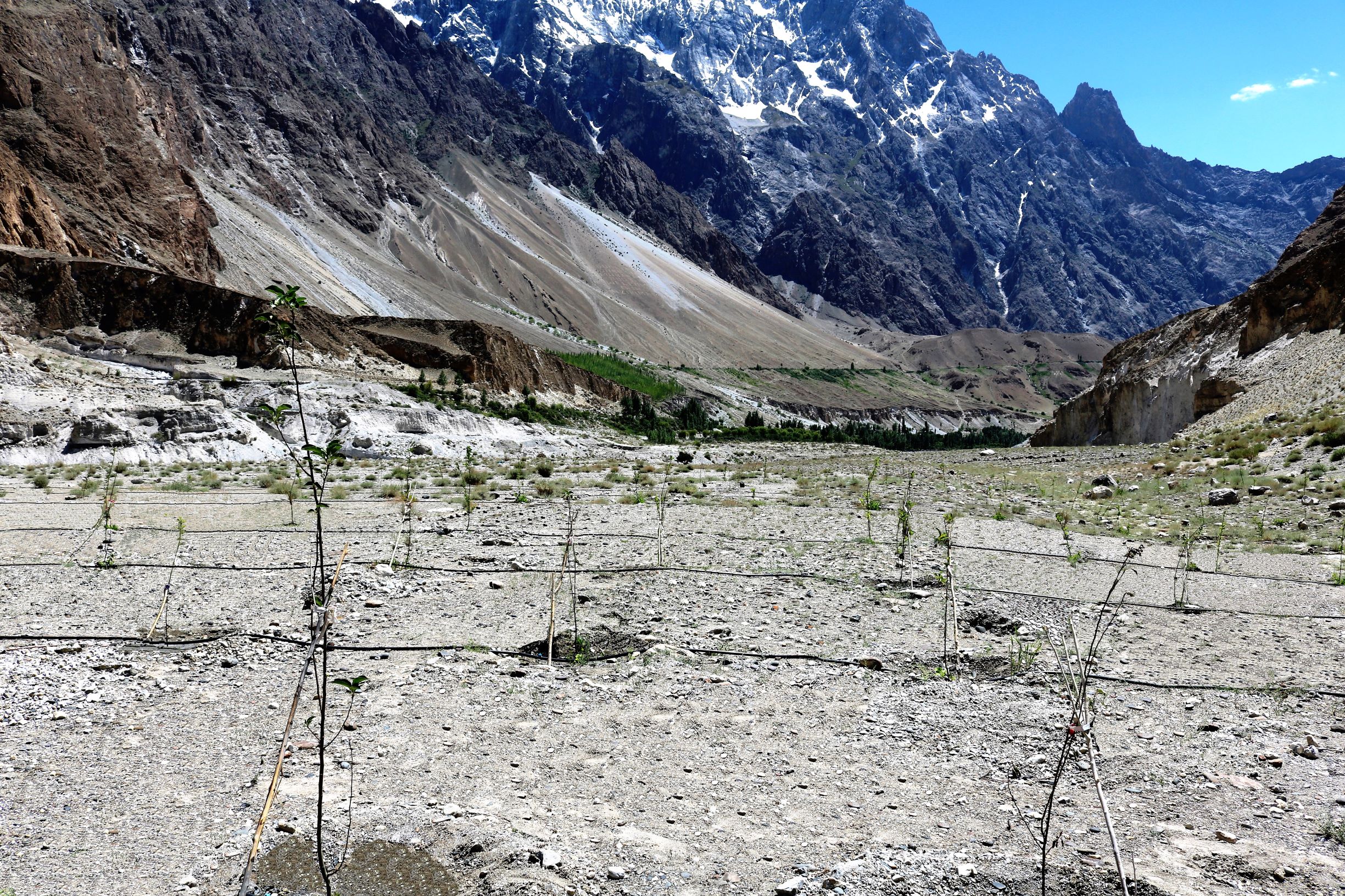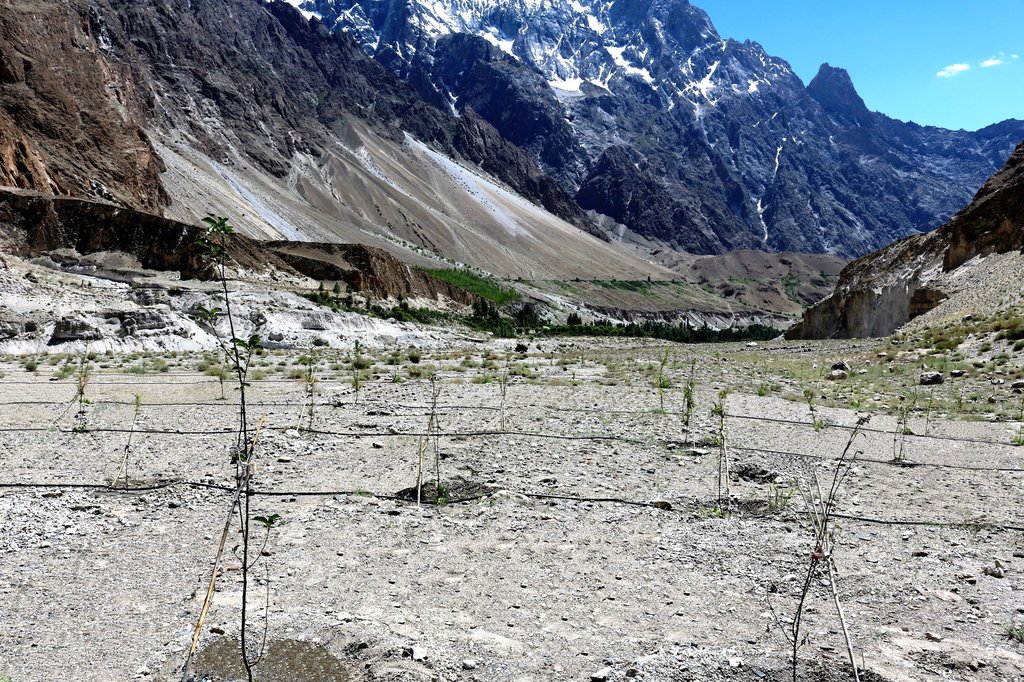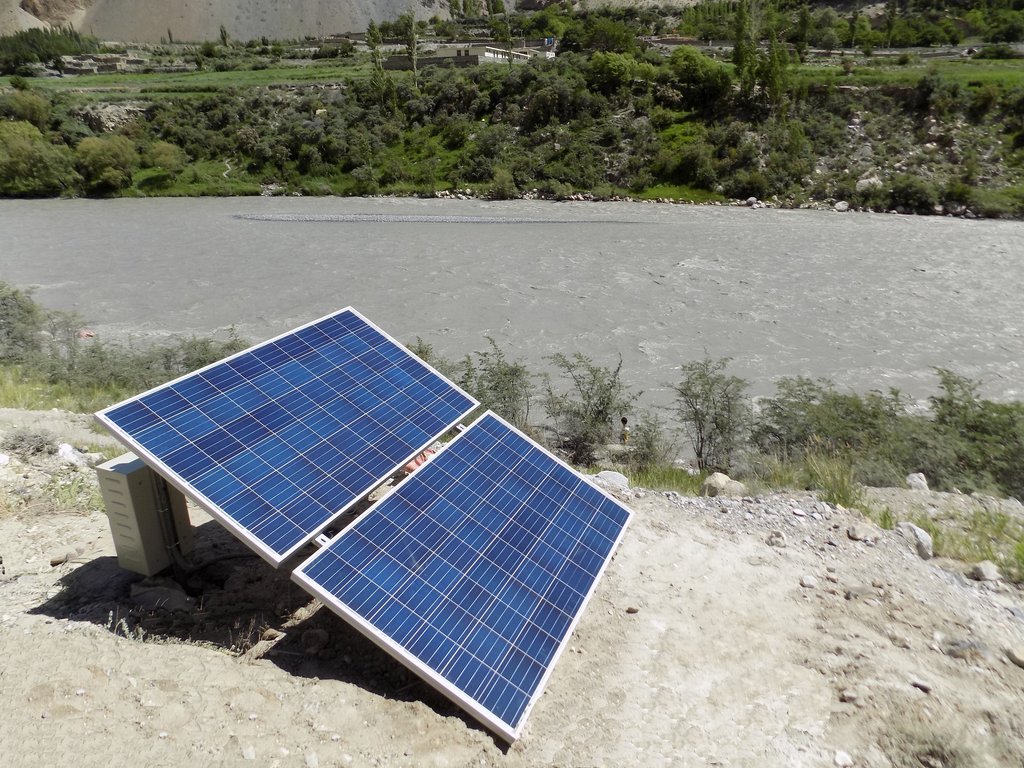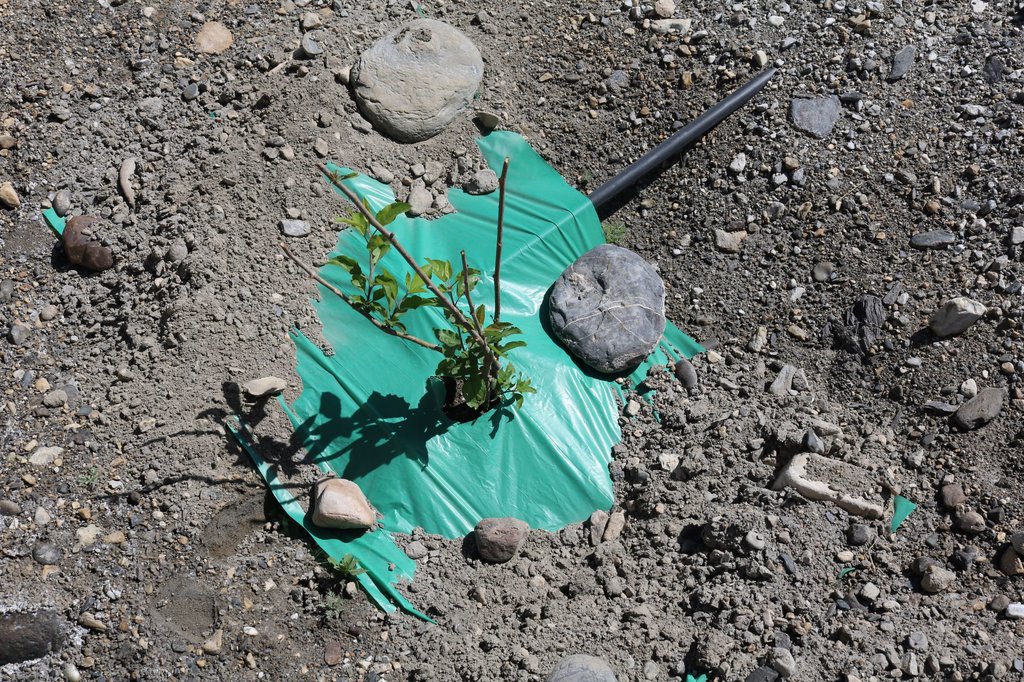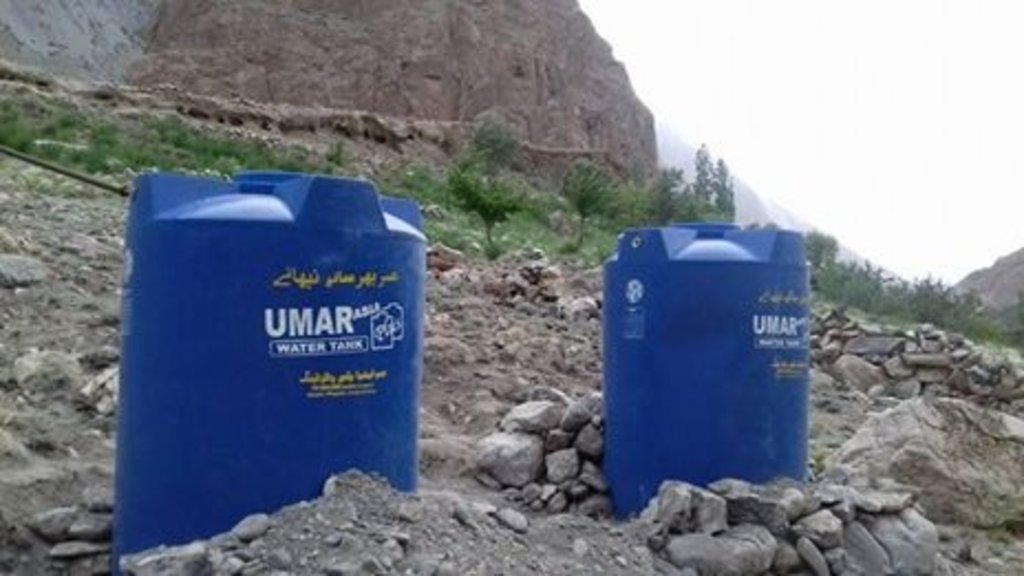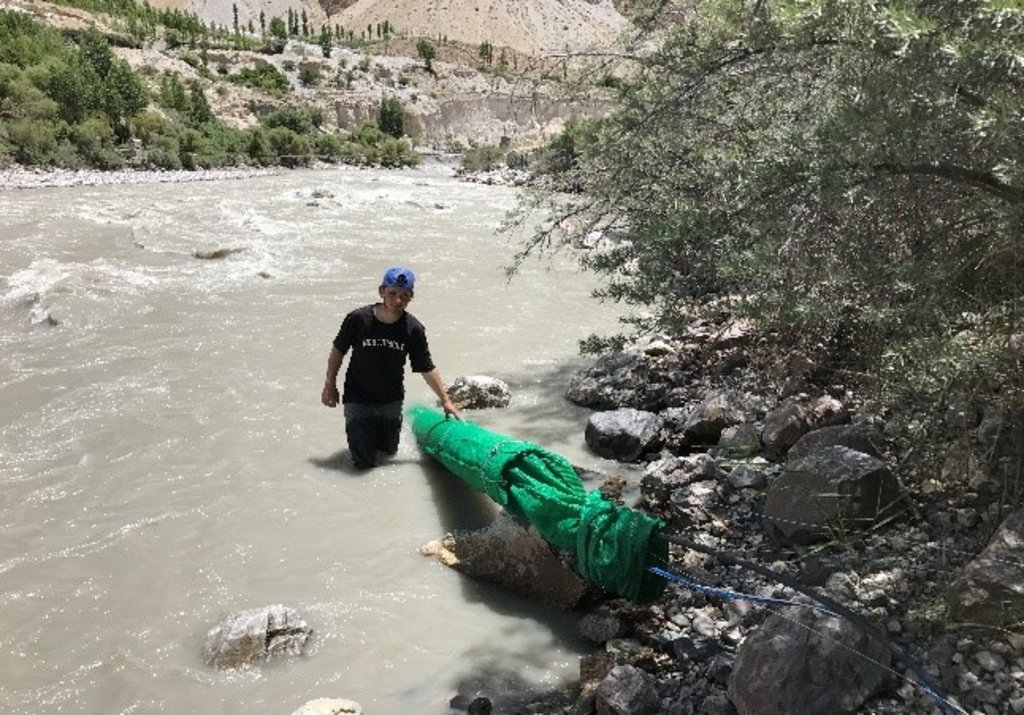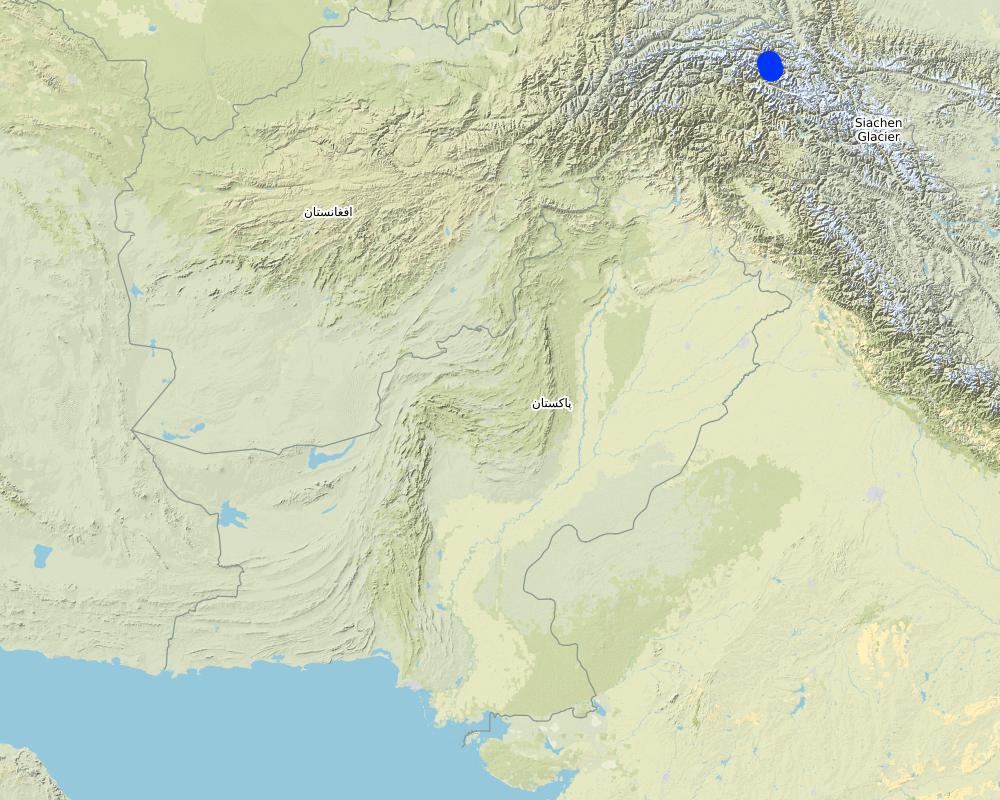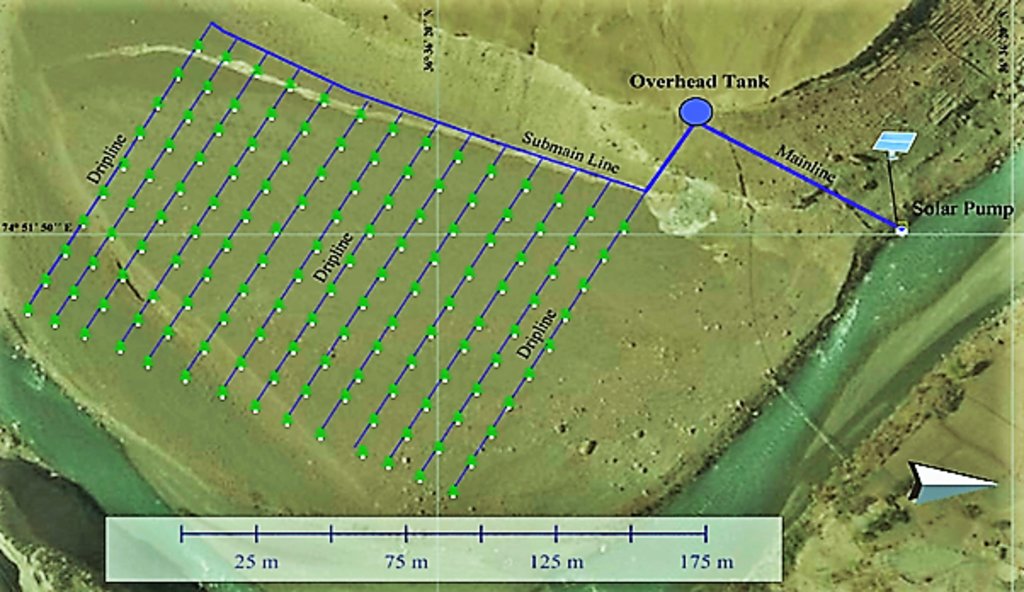Solar Power Water Lifting and Application to Orchard through Drip Irrigation [ปากีสถาน]
- ผู้สร้างสรรค์:
- การอัพเดท:
- ผู้รวบรวม: Madhav Dhakal
- ผู้เรียบเรียง: –
- ผู้ตรวจสอบ: Rima Mekdaschi Studer
technologies_5610 - ปากีสถาน
ดูส่วนย่อย
ขยายทั้งหมด ย่อทั้งหมด1. ข้อมูลทั่วไป
1.2 รายละเอียดที่ติดต่อได้ของผู้รวบรวมและองค์กรที่เกี่ยวข้องในการประเมินและการจัดเตรียมทำเอกสารของเทคโนโลยี
วิทยากรหลัก
ผู้เชี่ยวชาญ SLM:
Maqsood Muhammad Mudassar
International Centre for Integrated Mountain Development
ปากีสถาน
ผู้เชี่ยวชาญ SLM:
Shah Ghulam Muhammad
International Centre for Integrated Mountain Development
ปากีสถาน
ผู้เชี่ยวชาญ SLM:
Bhatti Ahmad Zeeshan
Pakistan Council of Research in Water Resources
ปากีสถาน
ผู้เชี่ยวชาญ SLM:
Khan Muhammad Zafar
Karakorum International University
ปากีสถาน
ผู้เชี่ยวชาญ SLM:
Khan Babar
World Wide Fund For Nature
ปากีสถาน
ผู้เชี่ยวชาญ SLM:
Ali Rehmat
World Wide Fund For Nature
ปากีสถาน
ผู้เชี่ยวชาญ SLM:
Ali Amjad
Karakorum International University
ปากีสถาน
ผู้เชี่ยวชาญ SLM:
Ali Ajaz
International Centre for Integrated Mountain Development
ปากีสถาน
ผู้เชี่ยวชาญ SLM:
Dhakal Madhav
International Centre for Integrated Mountain Development
เนปาล
ชื่อของโครงการซึ่งอำนวยความสะดวกในการทำเอกสารหรือการประเมินเทคโนโลยี (ถ้าเกี่ยวข้อง)
Agricultural Water, Energy, and Hazard Management for Improved Livelihood in the Upper Indus Basin, Pakistan (UIB, Pakistan)ชื่อขององค์กรซึ่งอำนวยความสะดวกในการทำเอกสารหรือการประเมินเทคโนโลยี (ถ้าเกี่ยวข้อง)
ICIMOD International Centre for Integrated Mountain Development (ICIMOD) - เนปาล1.3 เงื่อนไขการใช้ข้อมูลที่ได้บันทึกผ่านทาง WOCAT
ผู้รวบรวมและวิทยากรหลักยอมรับเงื่อนไขเกี่ยวกับการใช้ข้อมูลที่ถูกบันทึกผ่านทาง WOCAT:
ใช่
1.4 การเปิดเผยเรื่องความยั่งยืนของเทคโนโลยีที่ได้อธิบายไว้
เทคโนโลยีที่ได้อธิบายไว้นี้เป็นปัญหาของความเสื่อมโทรมโทรมของที่ดินหรือไม่ จึงไม่ได้รับการยอมรับว่าเป็นเทคโนโลยีเพื่อการจัดการที่ดินอย่างยั่งยืน:
ไม่ใช่
2. การอธิบายลักษณะของเทคโนโลยี SLM
2.1 การอธิบายแบบสั้น ๆ ของเทคโนโลยี
คำจำกัดความของเทคโนโลยี:
Water from the Hunza river was lifted through solar powered pump, stored above ground plastic tanks and applied to newly planted apple orchards through efficient drip irrigation. Mulch was applied to the plants to conserve soil moisture.
2.2 การอธิบายแบบละเอียดของเทคโนโลยี
คำอธิบาย:
The fragile rouged mountains prone to the effect of climate change makes the mountain com-munities in Gilgit-Baltistan of Pakistan more vulnerable. Agriculture is the major source of their livelihoods and it purely dependents on glacier meltwater which makes the community more susceptible due to the unstable behaviour of the glaciers. Irrigation is practised with traditional irrigation canals, intake of which is located at glacier terminus. On one hand lowering of glacier surface disconnects many irrigation canals. Uncertain glacier behaviour has resulted in the decline of water availability and even forced some communities to abandon their agricultural land. On the other hand, only 2% of land in Gilgit-Baltistan is used for agriculture purposes whereas a huge chunk of barren land lays above the Hunza River, which cannot be cultivated through the traditional irrigation system hence it remains unutilized.
To address both issues, ICIMOD together with a local level partner’s consortia piloted solar water lifting to irrigate barren land for establishing apple orchards along Hunza River at Passu and Morkhun Villages. These two villages are located far from each other. In each village, orchards of 2.5 hectare area were established and the drip irrigation system installed was efficiently used to irrigate apple plants. Similar technological packages (solar pump, drip irrigation and mulch) were applied in both the villages.
The pumping system comprises a submersible pump (Lorentz, Germany 1 HP) powered by 500 watts solar panels to carry the water to storage tanks (500 litres) made up of plastic that has been placed upslope at 100 feet vertical height from the river. The water from the storage tanks was routed/led to the apple saplings through the surface and pressure compensating drip irrigation system. The pumping capacity of the pump is 7.5 litres/minute, which is irrigating around 3300 apple plants at Passu and Morkhun. The storage tank was kept 60 feet vertical height from the orchard field to be irrigated. Tree to tree distance and row to row distance of apple was maintained at 15 feet in Passu and 10 feet in Morkhun. Drip irrigation (surface and pressure compensating) system was established to irrigate each apple plant, the emitter of the drip system was adjusted according to the plant to plant distance of apple seedlings to be irrigated. Pits were constructed for planting apples and later they also served as water harvesting pits /check basins. Plastic mulch was applied to each apple plants covering a radius around the trunk to minimize soil moisture losses, reduce weed and reduce soil erosion by water and wind.
The cost of an integrated package including solar pumps with accessories, storage tanks, intake and distribution systems (i.e. from river to tank and tank to trees), drip irrigation, apple plants and operational expenses (manpower) for both the sites was US$ 42000 for 5 ha of land. Village Development Organizations (VDO) of both villages take care of maintenance of technological package through a maintenance fund, which is being raised by participating households (HHs). Benefit sharing mechanism has been agreed among the participating HHs. The total income would be divided equally among participating 72 HHs in Morkhun and 135 HHs in Passu.
The technological package was applied in arid climate at an elevation ranging from 2340m to 4877 m above sea level. Passu is located at 36.49o latitude and 74.90o longitude and Morkhun is located at 36.6o N latitudes and 74.86o E longitudes. The area receives 150-200 mm annual rain-fall. The temperature ranges from 11 degree Celsius to 29 degree Celsius. The population of Passu and Morkhun is 1168 and 653 persons respectively. Both villages are semi nomadic and depend mainly on livestock rearing.
2.3 รูปภาพของเทคโนโลยี
2.4 วีดีโอของเทคโนโลยี
วันที่:
09/10/2018
สถานที่:
Morkhun and Passu
2.5 ประเทศภูมิภาค หรือสถานที่ตั้งที่เทคโนโลยีได้นำไปใช้และได้รับการครอบคลุมโดยการประเมินนี้
ประเทศ:
ปากีสถาน
ภูมิภาค/รัฐ/จังหวัด:
Gilgit Baltistan Province
ข้อมูลจำเพาะเพิ่มเติมของสถานที่ตั้ง :
Morkhun and Passu
ระบุการกระจายตัวของเทคโนโลยี:
- ใช้ ณ จุดที่เฉพาะเจาะจงหรือเน้นไปยังบริเวณพื้นที่ขนาดเล็ก
Is/are the technology site(s) located in a permanently protected area?
ไม่ใช่
Map
×2.6 วันที่การดำเนินการ
ระบุปีที่ใช้:
2016
ถ้าไม่รู้ปีที่แน่นอน ให้ระบุวันที่โดยประมาณ:
- น้อยกว่า 10 ปี (ไม่นานนี้)
2.7 คำแนะนำของเทคโนโลยี
ให้ระบุว่าเทคโนโลยีถูกแนะนำเข้ามาอย่างไร:
- ทางโครงการหรือจากภายนอก
ความคิดเห็น (ประเภทของโครงการ เป็นต้น) :
This package of practices was jointly implemented by Pakistan Council of Research in Water Resources (PCRWR), Worldwide Fund for Nature (WWF) - Pakistan, and ICIMOD
3. การจัดประเภทของเทคโนโลยี SLM
3.1 วัตถุประสงค์หลักของเทคโนโลยี
- ปรับปรุงการผลิตให้ดีขึ้น
- ลด ป้องกัน ฟื้นฟู การเสื่อมโทรมของที่ดิน
- ปรับตัวเข้ากับการเปลี่ยนแปลงภูมิอากาศของโลก สภาพภูมิอากาศที่รุนแรงและผลกระทบ
- สร้างผลกระทบทางด้านเศรษฐกิจที่เป็นประโยชน์
- สร้างผลกระทบทางด้านสังคมที่เป็นประโยชน์
3.2 ประเภทของการใช้ที่ดินในปัจจุบันที่ได้นำเทคโนโลยีไปใช้
Land use mixed within the same land unit:
ไม่ใช่

พื้นที่ปลูกพืช
- การปลูกไม้ยืนต้น ไม้พุ่ม
- Apple
จำนวนของฤดูเพาะปลูกต่อปี:
- 1
ระบุ:
April to October, rest months the region is covered with snow
Is intercropping practiced?
ไม่ใช่
Is crop rotation practiced?
ไม่ใช่
3.3 Has land use changed due to the implementation of the Technology?
Has land use changed due to the implementation of the Technology?
- Yes (Please fill out the questions below with regard to the land use before implementation of the Technology)
Land use mixed within the same land unit:
ไม่ใช่

พื้นที่ปลูกพืช
- Unproductive
Is intercropping practiced?
ไม่ใช่
Is crop rotation practiced?
ไม่ใช่
3.4 การใช้น้ำ
การใช้น้ำของที่ดินที่มีการใช้เทคโนโลยีอยู่:
- การชลประทานแบบเต็มรูปแบบ
แสดงความคิดเห็น:
Water supply with solar pump and distribution to apple with drip irrigation
3.5 กลุ่ม SLM ที่ตรงกับเทคโนโลยีนี้
- การจัดการด้านชลประทาน (รวมถึงการลำเลียงส่งน้ำ การระบายน้ำ)
- การจัดการน้ำผิวดิน (น้ำพุ แม่น้ำทะเลสาบ ทะเล)
- ประสิทธิภาพด้านพลังงาน
3.6 มาตรการ SLM ที่ประกอบกันเป็นเทคโนโลยี

มาตรการอนุรักษ์ด้วยวิธีพืช
- V1: ต้นไม้และพุ่มไม้คลุมดิน

มาตรการอนุรักษ์ด้วยการจัดการ
- M1: การเปลี่ยนรูปแบบของการใช้ประโยชน์ที่ดิน
3.7 รูปแบบหลักของการเสื่อมโทรมของที่ดินที่ได้รับการแก้ไขโดยเทคโนโลยี

การกัดกร่อนของดินโดยน้ำ
- Wt (Loss of topsoil): การสูญเสียดินชั้นบนหรือการกัดกร่อนที่ผิวดิน

การกัดกร่อนของดินโดยลม
- Et (Loss of topsoil): การสูญเสียดินชั้นบน

การเสื่อมโทรมของน้ำ
- Ha (Aridification): การเกิดความแห้งแล้ง

อื่น ๆ
ระบุ:
Damage and dysfunction of irrigation canal .
แสดงความคิดเห็น:
Damage and dysfunction of irrigation canal intake by shifting nature of glacier as intakes are located at the glacier terminus.
3.8 การป้องกัน การลดลง หรือการฟื้นฟูความเสื่อมโทรมของที่ดิน
ระบุเป้าหมายของเทคโนโลยีกับความเสื่อมโทรมของที่ดิน:
- ฟื้นฟูบำบัดที่ดินที่เสื่อมโทรมลงอย่างมาก
แสดงความคิดเห็น:
due to water access cultivation was possible and vegetation cover improved.
4. ข้อมูลจำเพาะด้านเทคนิค กิจกรรมการนำไปปฏิบัติใช้ ปัจจัยนำเข้า และค่าใช้จ่าย
4.1 แบบแปลนทางเทคนิคของเทคโนโลยี
ข้อมูลจำเพาะด้านเทคนิค (แบบแปลนทางเทคนิคของเทคโนโลยี):
Solar Pump: DC submersible (Lorentz, Germany 1 HP), the capacity of Panels: 500 watts, and pumping capacity of the pump: 7.5 litres/minute.
The capacity of storage tank: 500 litres, location of storage tank: 100 feet height (vertical) from the river and 60 feet height (vertical) from the orchard field.
Drip Irrigation: Surface and pressure compensating. The spacing of dripping points: 10 feet in Morkhun and 15 feet in Passu. Water application per plant by drip irrigation is 2 litres per day.
Plant to plant and row to row distance of apple 10 feet in Morkhun and 15 feet ( both plant to plant and row to row) in Passu coinciding with the dripping holes.
Pits: Constructed for planting apples, later they served as water harvesting pits /check basins.
Plastic mulch: In each plant. Shape of the plastic mulch is rectangular and dimension is variable, average about 5 ft long and 3 feet wide. It is an opaque plastic sheet.
ผู้เขียน:
Muhammad Mudassar Maqsood)
วันที่:
09/10/2018
4.2 ข้อมูลทั่วไปเกี่ยวกับการคำนวณปัจจัยนำเข้าและค่าใช้จ่าย
ให้ระบุว่าค่าใช้จ่ายและปัจจัยนำเข้าได้รับการคำนวณอย่างไร:
- ต่อหน่วยเทคโนโลยี
โปรดระบุหน่วย:
Technological package at two sites ( solar system, water storage tank, drip, orchard establishment, and mulch) , same package is applied in two sites separately. Total area of two sites is 5 ha
ระบุสกุลเงินที่ใช้คำนวณค่าใช้จ่าย:
- USD
ระบุค่าเฉลี่ยของค่าจ้างในการจ้างแรงงานต่อวัน:
US$ 14.5 for skilled person and US$ 7.5 for unskilled person
4.3 กิจกรรมเพื่อการจัดตั้ง
| กิจกรรม | Timing (season) | |
|---|---|---|
| 1. | Site identification in consultation with the communities | Pre Monsson (March) |
| 2. | Detailed engineering surveys, design formulation, tendering and work orders etc | Pre Monsson (March ) |
| 3. | Implementation agreement with the community | Pre Monsson (March) |
| 4. | Installation of solar-powered pumping units with four poly-crystalline solar panels. | Pre Monsson (April) |
| 5. | Installation of storage (plastic tank) with a line filter attached to it for the operation of the drip system and avoid sediment entry into the tank | Pre Monsson (April) |
| 6. | Digging of pits for plantation of the apple orchard at the plant to plant and row distance of 10 feet (Morkhun) and 15 feet (Passu)) | Pre Monsson (April) |
| 7. | Constructed pits for each plant used for application of compost | Pre Monsson (April) |
| 8. | Laying of drip irrigation systems | Pre Monsson (May) |
| 9. | Laying down plastic mulch | Pre Monsson (May) |
| 10. | Plantation of tubed apple (Kala Kolu variety) it is bought from the local nursery | Pre Monsson (May) |
| 11. | Training to selected farmers as caretakers of the technologies for its days to day repair and maintenance | Pre Monsson ( May) |
4.4 ค่าใช้จ่ายของปัจจัยนำเข้าที่จำเป็นสำหรับการจัดตั้ง
| ปัจจัยนำเข้า | หน่วย | ปริมาณ | ค่าใช้จ่ายต่อหน่วย | ค่าใช้จ่ายทั้งหมดต่อปัจจัยนำเข้า | %ของค่าใช้จ่ายที่ก่อให้เกิดขึ้นโดยผู้ใช้ที่ดิน | |
|---|---|---|---|---|---|---|
| แรงงาน | Skilled | Person days | 136.0 | 14.43 | 1962.48 | |
| แรงงาน | Unskilled | Person days | 745.0 | 7.7 | 5736.5 | |
| อุปกรณ์ | Spade | Number | 20.0 | 0.0 | 0.0 | 100.0 |
| อุปกรณ์ | Shovel | Number | 20.0 | 0.0 | 0.0 | 100.0 |
| อุปกรณ์ | Plumbing tool kit | Kit box | 1.0 | 0.0 | 0.0 | 100.0 |
| วัสดุด้านพืช | Apple Plants | Number | 3300.0 | 0.087 | 287.1 | |
| วัสดุสำหรับก่อสร้าง | Solar panel, pump with all accessories | sites | 2.0 | 6490.0 | 12980.0 | |
| วัสดุสำหรับก่อสร้าง | Water storage, intake, distribution pipes and mulch | sites | 2.0 | 6861.0 | 13722.0 | |
| วัสดุสำหรับก่อสร้าง | Drip irrigation | sites | 2.0 | 4173.0 | 8346.0 | |
| วัสดุสำหรับก่อสร้าง | -Check basin (pits) | number | 3300.0 | 0.466 | 1537.8 | |
| ค่าใช้จ่ายทั้งหมดของการจัดตั้งเทคโนโลยี | 44571.88 | |||||
| Total costs for establishment of the Technology in USD | 44571.88 | |||||
ถ้าผู้ใช้ที่ดินรับภาระน้อยกว่า 100% ของค่าใช้จ่าย ให้ระบุว่าใครเป็นผู้รับผิดชอบส่วนที่เหลือ:
The technological package was designed and implemented by ICIMOD's Indus Basin Initiative with partners and contributes to the sustainable Development Investment Portfolio and is supported by the Australian Aid program.
แสดงความคิดเห็น:
Establishment costs and inputs for a solar pump –drip irrigation - mulch system was estimated for apple orchards piloted on a 5 hectares of total land in two villages.
4.5 การบำรุงรักษาสภาพหรือกิจกรรมที่เกิดขึ้นเป็นประจำ
| กิจกรรม | ช่วงระยะเวลา/ความถี่ | |
|---|---|---|
| 1. | Monitoring of water pumping, storage, and drip system by a regular visit to the site. | Regular (annually) |
| 2. | Repair and maintenance of solar pump panel and drip irrigation: fixing clogged drip lines and replacement of broken solar panel and cleaning of impellers of the solar pump. | Regular (annually) |
| 3. | Replacement of dead apple plants | As and when required |
4.6 ค่าใช้จ่ายของปัจจัยนำเข้าและกิจกรรมที่เกิดขึ้นเป็นประจำที่ต้องการการบำรุงรักษา (ต่อปี)
| ปัจจัยนำเข้า | หน่วย | ปริมาณ | ค่าใช้จ่ายต่อหน่วย | ค่าใช้จ่ายทั้งหมดต่อปัจจัยนำเข้า | %ของค่าใช้จ่ายที่ก่อให้เกิดขึ้นโดยผู้ใช้ที่ดิน | |
|---|---|---|---|---|---|---|
| แรงงาน | Unskilled | Number | 26.0 | 7.7 | 200.2 | |
| อุปกรณ์ | Spade | Number | 10.0 | 0.0 | 0.0 | 100.0 |
| อุปกรณ์ | Plumbing tool kit | Kit box | 1.0 | 0.0 | 0.0 | 100.0 |
| วัสดุด้านพืช | Apple ( replacement of dead plants) | number | 330.0 | 0.087 | 28.71 | |
| ค่าใช้จ่ายทั้งหมดของการบำรุงรักษาสภาพเทคโนโลยี | 228.91 | |||||
| Total costs for maintenance of the Technology in USD | 228.91 | |||||
4.7 ปัจจัยสำคัญที่สุดที่มีผลกระทบต่อค่าใช้จ่าย
ปัจจัยสำคัญที่สุดที่มีผลกระทบต่อค่าใช้จ่ายต่างๆ:
Equipment and labor
5. สิ่งแวดล้อมทางธรรมชาติและของมนุษย์
5.1 ภูมิอากาศ
ฝนประจำปี
- < 250 ม.ม.
- 251-500 ม.ม.
- 501-750 ม.ม.
- 751-1,000 ม.ม.
- 1,001-1,500 ม.ม.
- 1,501-2,000 ม.ม.
- 2,001-3,000 ม.ม.
- 3,001-4,000 ม.ม.
- > 4,000 ม.ม.
ระบุปริมาณน้ำฝนเฉลี่ยรายปี (ถ้ารู้) :หน่วย ม.ม.
150.00
ข้อมูลจำเพาะ/ความคิดเห็นเรื่องปริมาณน้ำฝน:
it varies from 150 mm to 200 mm
ระบุชื่อของสถานีตรวดวัดอากาศที่ใช้อ้างอิงคือ:
Passu ghar
เขตภูมิอากาศเกษตร
- แห้งแล้ง
5.2 สภาพภูมิประเทศ
ค่าเฉลี่ยความลาดชัน:
- ราบเรียบ (0-2%)
- ลาดที่ไม่ชัน (3-5%)
- ปานกลาง (6-10%)
- เป็นลูกคลื่น (11-15%)
- เป็นเนิน (16-30%)
- ชัน (31-60%)
- ชันมาก (>60%)
ธรณีสัณฐาน:
- ที่ราบสูง/ที่ราบ
- สันเขา
- ไหล่เขา
- ไหล่เนินเขา
- ตีนเนิน
- หุบเขา
ระดับความสูง:
- 0-100 เมตร
- 101-500 เมตร
- 501-1,000 เมตร
- 1,001-1,500 เมตร
- 1,501-2,000 เมตร
- 2,001-2,500 เมตร
- 2,501-3,000 เมตร
- 3,001-4,000 เมตร
- > 4,000 เมตร
ให้ระบุถ้าเทคโนโลยีได้ถูกนำไปใช้:
- ไม่เกี่ยวข้อง
5.3 ดิน
ค่าเฉลี่ยความลึกของดิน:
- ตื้นมาก (0-20 ซ.ม.)
- ตื้น (21-50 ซ.ม.)
- ลึกปานกลาง (51-80 ซ.ม.)
- ลึก (81-120 ซ.ม.)
- ลึกมาก (>120 ซ.ม.)
เนื้อดิน (ดินชั้นบน):
- หยาบ/เบา (ดินทราย)
เนื้อดินล่าง (> 20 ซ.ม.ต่ำจากผิวดิน):
- หยาบ/เบา (ดินทราย)
อินทรียวัตถุในดิน:
- ต่ำ (<1%)
5.4 ความเป็นประโยชน์และคุณภาพของน้ำ
ระดับน้ำใต้ดิน:
5-50 เมตร
น้ำไหลบ่าที่ผิวดิน:
ดี
คุณภาพน้ำ (ที่ยังไม่ได้บำบัด):
เป็นน้ำใช้เพื่อการเกษตรเท่านั้น (การชลประทาน)
Water quality refers to:
surface water
ความเค็มของน้ำเป็นปัญหาหรือไม่:
ไม่ใช่
กำลังเกิดน้ำท่วมในพื้นที่หรือไม่:
ใช่
บ่อยครั้ง:
บ่อยครั้ง
ความคิดเห็นและข้อมูลจำเพาะเพิ่มเติมเรื่องคุณภาพและปริมาณน้ำ:
Water is available in the river but fields are higher up than river
5.5 ความหลากหลายทางชีวภาพ
ความหลากหลายทางชนิดพันธุ์:
- ต่ำ
ความหลากหลายของแหล่งที่อยู่:
- ต่ำ
5.6 ลักษณะของผู้ใช้ที่ดินที่นำเทคโนโลยีไปปฏิบัติใช้
อยู่กับที่หรือเร่ร่อน:
- กึ่งเร่ร่อน
แนวทางการตลาดของระบบการผลิต:
- เพื่อการยังชีพ (หาเลี้ยงตนเอง)
รายได้ที่มาจากนอกฟาร์ม:
- > 50% ของรายได้ทั้งหมด
ระดับของความมั่งคั่งโดยเปรียบเทียบ:
- พอมีพอกิน
เป็นรายบุคคล/ครัวเรือน:
- กลุ่ม/ชุมชน
ระดับของการใช้เครื่องจักรกล:
- งานที่ใช้แรงกาย
- การใช้กำลังจากสัตว์
เพศ:
- ชาย
อายุของผู้ใช้ที่ดิน:
- วัยกลางคน
ระบุลักษณะอื่นๆที่เกี่ยวข้องของผู้ใช้ที่ดิน:
Relative level of wealth: Poor 35 %, average 65%
5.7 Average area of land used by land users applying the Technology
- < 0.5 เฮกตาร์
- 0.5-1 เฮกตาร์
- 1-2 เฮกตาร์
- 2-5 เฮกตาร์
- 5-15 เฮกตาร์
- 15-50 เฮกตาร์
- 50-100 เฮกตาร์
- 100-500 เฮกตาร์
- 500-1,000 เฮกตาร์
- 1,000-10,000 เฮกตาร์
- >10,000 เฮกตาร์
พิจารณาว่าเป็นขนาดเล็ก กลาง หรือขนาดใหญ่ (ซึ่งอ้างอิงถึงบริบทระดับท้องถิ่น):
- ขนาดเล็ก
5.8 กรรมสิทธิ์ในที่ดิน สิทธิในการใช้ที่ดินและสิทธิในการใช้น้ำ
กรรมสิทธิ์ในที่ดิน:
- รายบุคคล ได้รับสิทธิครอบครอง
สิทธิในการใช้ที่ดิน:
- รายบุคคล
สิทธิในการใช้น้ำ:
- เกี่ยวกับชุมชน (ถูกจัดระเบียบ)
Are land use rights based on a traditional legal system?
ใช่
ระบุ:
Most of the uncultivated land is communal, community decides uses of the land
5.9 การเข้าถึงบริการและโครงสร้างพื้นฐาน
สุขภาพ:
- จน
- ปานกลาง
- ดี
การศึกษา:
- จน
- ปานกลาง
- ดี
ความช่วยเหลือทางด้านเทคนิค:
- จน
- ปานกลาง
- ดี
การจ้างงาน (เช่น ภายนอกฟาร์ม):
- จน
- ปานกลาง
- ดี
ตลาด:
- จน
- ปานกลาง
- ดี
พลังงาน:
- จน
- ปานกลาง
- ดี
ถนนและการขนส่ง:
- จน
- ปานกลาง
- ดี
น้ำดื่มและการสุขาภิบาล:
- จน
- ปานกลาง
- ดี
บริการด้านการเงิน:
- จน
- ปานกลาง
- ดี
6. ผลกระทบและสรุปคำบอกกล่าว
6.1 ผลกระทบในพื้นที่ดำเนินการ (On-site) จากการใช้เทคโนโลยี
ผลกระทบทางด้านเศรษฐกิจและสังคม
การผลิต
พื้นที่สำหรับการผลิต
หลังจาก SLM:
5 ha
แสดงความคิดเห็น/ระบุ:
Production area increased as uncultivated land brought under cultivation, but crop production has not increased yet because orchard just established.
การผลิตพลังงาน
แสดงความคิดเห็น/ระบุ:
Use of renewable solar energy for fruit cultivation
ความเป็นประโยชน์และคุณภาพของน้ำ
การมีน้ำไว้ให้สำหรับการชลประทาน
แสดงความคิดเห็น/ระบุ:
Irrigation water availability increased with innovative technological packages.
ผลกระทบด้านสังคมวัฒนธรรมอื่น ๆ
สถาบันของชุมชน
แสดงความคิดเห็น/ระบุ:
Community institution (village development organizations) strengthened due to the approach of farming in a group.
SLM หรือความรู้เรื่องความเสื่อมโทรมของที่ดิน
แสดงความคิดเห็น/ระบุ:
Land management skills of community enhanced due to various training such as crop cultivation, operation and maintenance of water conservation and management technologies.
ผลกระทบด้านนิเวศวิทยา
ดิน
ความชื้นในดิน
แสดงความคิดเห็น/ระบุ:
Improved soil moisture as a result of water harvesting pits, mulching and efficient drip irrigation.
สิ่งปกคลุมดิน
แสดงความคิดเห็น/ระบุ:
improved soil cover due to mulch.
การสูญเสียดิน
แสดงความคิดเห็น/ระบุ:
Reduced soil loss ( from wind and water erosion) due to application of mulch and also due to vegetation cover and above-ground biomass.
ผลกระทบด้านนิเวศวิทยาอื่น ๆ
แสดงความคิดเห็น/ระบุ:
The technological package is climate change resilient as compared to the melt water dependant surface flood irrigation. Melt water of glacier and snow is very sensitive to climate change. Glaciers are dynamic, their depth and volume fluctuation happens each year.
6.2 ผลกระทบนอกพื้นที่ดำเนินการ (Off-site) จากการใช้เทคโนโลยี
น้ำท่วมพื้นที่ท้ายน้ำ
แสดงความคิดเห็น/ระบุ:
Reduced risk of downstream flooding though the amount is very less.
6.3 การเผชิญและความตอบสนองของเทคโนโลยีต่อการเปลี่ยนแปลงสภาพภูมิอากาศที่ค่อยเป็นค่อยไป และสภาพรุนแรงของภูมิอากาศ / ภัยพิบัติ (ที่รับรู้ได้โดยผู้ใช้ที่ดิน)
สภาพรุนแรงของภูมิอากาศ (ภัยพิบัติ)
ภัยพิบัติทางอุตุนิยมวิทยา
| เทคโนโลยีมีวิธีการรับมืออย่างไร | |
|---|---|
| พายุลมประจำท้องถิ่น | ดี |
ภัยพิบัติจากสภาพภูมิอากาศ
| เทคโนโลยีมีวิธีการรับมืออย่างไร | |
|---|---|
| สภาพอากาศฤดูหนาวที่รุนแรง | ดี |
| ภัยจากฝนแล้ง | ดี |
ภัยพิบัติจากน้ำ
| เทคโนโลยีมีวิธีการรับมืออย่างไร | |
|---|---|
| น้ำท่วมฉับพลัน | ปานกลาง |
สภาพรุนแรงของภูมิอากาศ (ภัยพิบัติ) อื่น ๆ
| อื่น ๆ (ระบุ) | เทคโนโลยีมีวิธีการรับมืออย่างไร |
|---|---|
| Heavy load of suspended river sediment | ดี |
แสดงความคิดเห็น:
Drip is sensitive to temperature increase; but tolerant to wind storms/dust storms and floods. Solar panel is tolerant to temperature increase.
The solar panel is sensitive to wind storm. The pump is sensitive to flood and sediment load in the river, emitters of drip clog due to sediment. Mulch is sensitive to windstorm. Apple plants at an earlier stage are sensitive to wind storm, plants are sensitive to extreme winter conditions (low temp and snowfall)
6.4 การวิเคราะห์ค่าใช้จ่ายและผลประโยชน์ที่ได้รับ
ผลประโยชน์ที่ได้รับเปรียบเทียบกับค่าใช้จ่ายในการจัดตั้งเป็นอย่างไร (จากมุมมองของผู้ใช้ที่ดิน)
ผลตอบแทนระยะสั้น:
ด้านลบ
ผลตอบแทนระยะยาว:
ด้านบวก
ผลประโยชน์ที่ได้รับเปรียบเทียบกับค่าใช้จ่ายในการบำรุงรักษาหรือต้นทุนที่เกิดขึ้นซ้ำอีก เป็นอย่างไร (จากมุมมองของผู้ใช้ที่ดิน)
ผลตอบแทนระยะสั้น:
ด้านลบ
ผลตอบแทนระยะยาว:
ด้านบวกอย่างมาก
แสดงความคิดเห็น:
The initial cost of investment would be fully recovered in 10.9 years, hence the payback period of the project is around 11 years, and the repayment of the investment would start from the eight years. Benefit-Cost Ratio is found to be 4.96.
6.5 การปรับตัวของเทคโนโลยี
- 1-10%
ถ้ามีข้อมูลให้บอกปริมาณด้วย (จำนวนของครัวเรือนหรือครอบคลุมพื้นที่):
45 Households
แสดงความคิดเห็น:
None
6.6 การปรับตัว
เทคโนโลยีได้รับการปรับเปลี่ยนเมื่อเร็วๆนี้ เพื่อให้ปรับตัวเข้ากับสภาพที่กำลังเปลี่ยนแปลงหรือไม่:
ใช่
ถ้าตอบว่าใช่ ให้ระบุว่าเงื่อนไขการเปลี่ยนแปลงใดที่ถูกปรับตัว:
- การเปลี่ยนแปลงแบบค่อยเป็นค่อยไปและสภาพรุนแรงของภูมิอากาศ
ให้ระบุการปรับตัวของเทคโนโลยี (การออกแบบ วัสดุหรือชนิดพันธุ์ เป็นต้น):
Due to heavy load of suspended sediment flowing in the Hunza River, impellers of the solar pump couldn’t function properly. Site-specific customiza-tion of the pump was carried out to make the system functional and to sustain it in the long run.
For that, an outer filter was developed for the pump to avoid sediment entry into the pump. The outer filter is UPVC pipe (of 10-inch diameter and 13 ft long) wrapped with a finely-meshed green net. The out filter was tightly bound together with the pump. The filter with the pump was placed in the river, transverse to the direction of flow. The farmers are also trained to open the clogged drip to release the sediments from time to time.
Damaged solar panel sometimes was replaced. A portion of mulch was buried under the soil. Apple plants were tied together with support stakes. Application of mulch helped to protect apple plants from low winter temperature.
6.7 จุดแข็ง / ข้อได้เปรียบ / โอกาสของเทคโนโลยี
| จุดแข็ง / ข้อได้เปรียบ / โอกาสในทัศนคติของผู้ใช้ที่ดิน |
|---|
| The solar powered water lifting and drip irrigation is the first of its kind in the upper Indus basin. The system is simple and anyone once trained can operate it. It will contribute to nearly 50% of the additional income of the Passu community. |
| The technological package is environmentally friendly and are effective adaptation measures in the context of climate change. |
| Women are often most involved in agricultural activities and this intervention has provided them relief by making it possible for them to work nearer to their valley. More over, once the trees bear fruit, women will be able to sell them to generate income. |
| จุดแข็ง / ข้อได้เปรียบ / โอกาสในทัศนคติของผู้รวบรวมหรือวิทยากรหลัก |
|---|
| The first innovative technological package in GB that is climate-resilient as compare to meltwater-dependent flood irrigation is operated by renewable solar energy. |
| Water application through drip irrigation is very efficient as compared to flood irrigation, per plant water applied trough drip is 2 litres/day as compared to 30 litres/day through flood irrigation. Integration of mulch enhances soil moisture. |
| The technological package can last more than 20 years. Maintenance cost is nominal, it is US$ 100 at the initial stage and later stage it is US$ 300. |
| As women are predominantly responsible for farming activities, im-proved water access and application through drip reduces their work-load and frees up time for other activities |
6.8 จุดอ่อน / ข้อเสียเปรียบ / ความเสี่ยงของเทคโนโลยีและวิธีการแก้ไข
| จุดอ่อน / ข้อเสียเปรียบ / ความเสี่ยงในทัศนคติของผู้ใช้ที่ดิน | มีวิธีการแก้ไขได้อย่างไร |
|---|---|
| Frequent maintenance operation and maintenance of the solar pump due to high sediment concentration of the river from where water is pumped. | Include capacity building activities as an integral part of the technology implementation process. |
| Drip irrigation and parts of solar panel may not available locally | A spare parts should be made available locally for immediate replacement as and when required. |
| จุดอ่อน / ข้อเสียเปรียบ / ความเสี่ยงในทัศนคติของผู้รวบรวมหรือวิทยากรหลัก | มีวิธีการแก้ไขได้อย่างไร |
|---|---|
| The investment cost is high . | Explain cost-benefit analysis to aware farmers that the benefit is high in the long run. |
| Techniques of multiple cropping were not practised to get short term benefits from the orchard field. | Engage the agricultural department to demonstrate and train farmers on multiple cropping in the dry land. |
7. การอ้างอิงและการเชื่อมต่อ
7.1 วิธีการและแหล่งข้อมูล
- ไปเยี่ยมชมภาคสนาม การสำรวจพื้นที่ภาคสนาม
Field visits was done several times as this was a part of the project activity. Cost benefit analysis was done in 2019.
- การสัมภาษณ์กับผู้ใช้ที่ดิน
Frequently with beneficiaries of the SLM technological packages (around 50 households) .
7.2 การอ้างอิงถึงสิ่งตีพิมพ์
หัวข้อ, ผู้เขียน, ปี, หมายเลข ISBN:
ICIMOD 2017. An Innovative Approach to Agricultural Water Management in the Upper Indus basin: the Water_Energy-Food Nexus at the Local Level
ชื่อเรื่อง ผู้เขียน ปี ISBN:
http://lib.icimod.org/record/32794/files/Innovative%20Approach.pdf
หัวข้อ, ผู้เขียน, ปี, หมายเลข ISBN:
Kifayat, U., Khan, F. A., & Ejaz, A. (2014). Determinants of poverty in the mountain region of Gilgit-Baltistan, Pakistan. Developing Country Studies, 4(7), 10-19.
ชื่อเรื่อง ผู้เขียน ปี ISBN:
Google scholar
หัวข้อ, ผู้เขียน, ปี, หมายเลข ISBN:
Amjad Ali 2019. Unpublished report on cost-benefit analysis of UIB phase 1 intervention in Upper Hunza
ชื่อเรื่อง ผู้เขียน ปี ISBN:
ICIMOD
7.4 General comments
It has been improved a lot as compared to past 10 years .
ลิงก์และโมดูล
ขยายทั้งหมด ย่อทั้งหมดลิงก์
ไม่มีลิงก์
โมดูล
ไม่มีโมดูล


